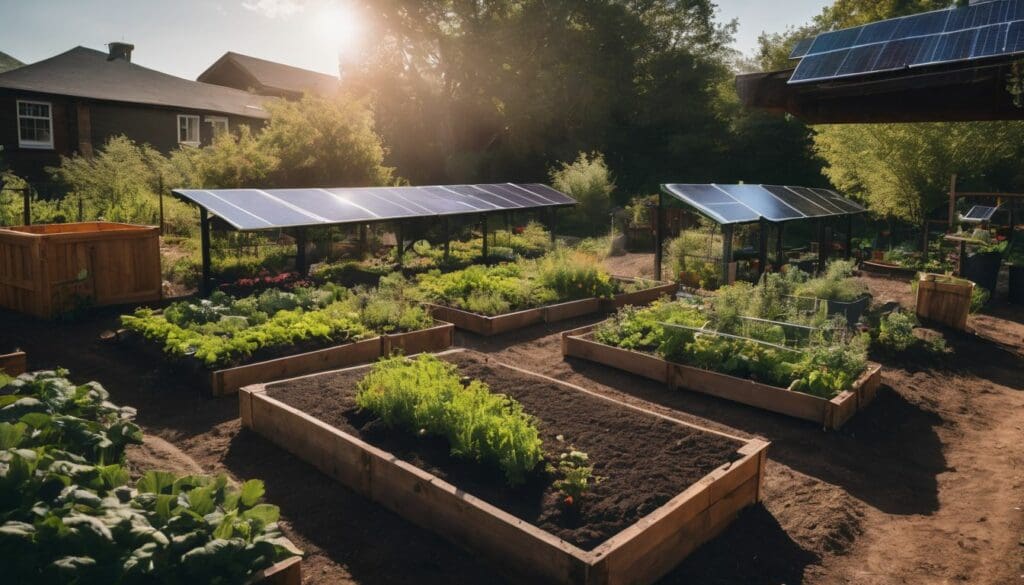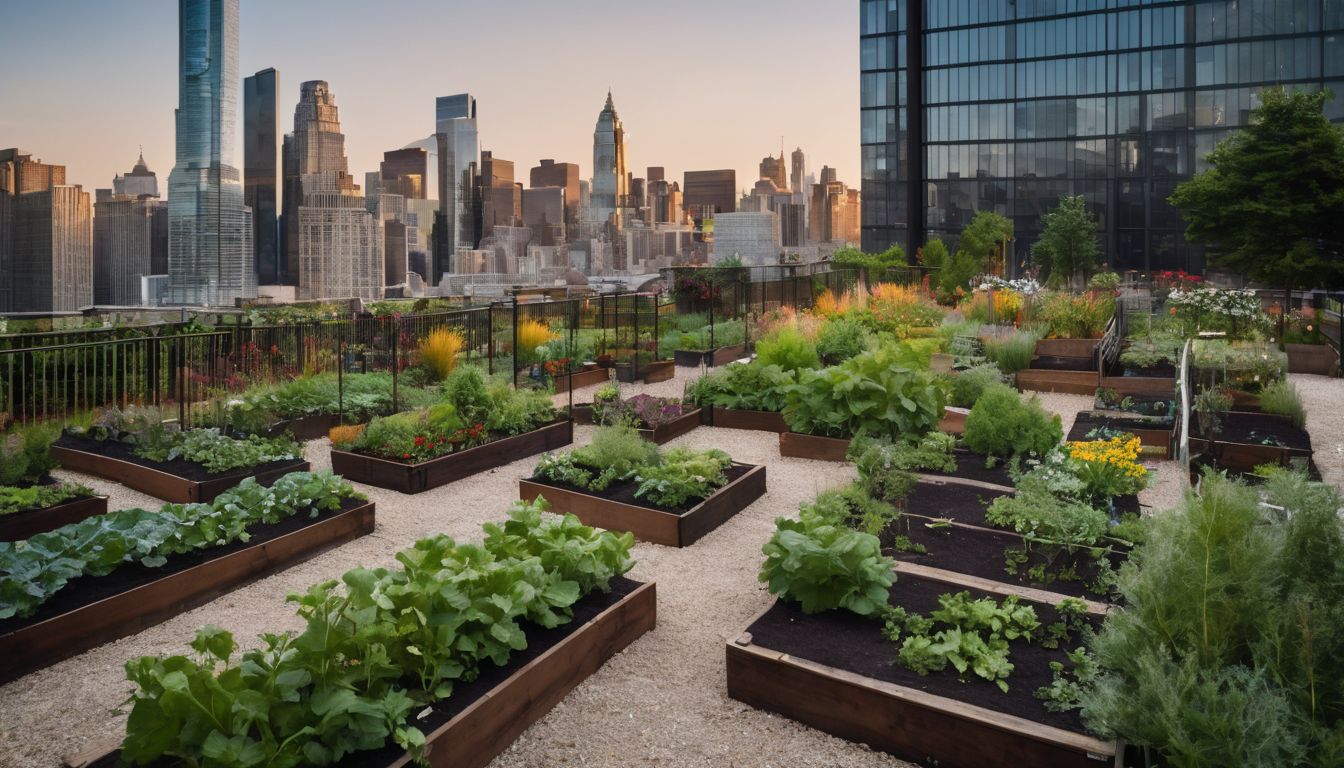It’s clear we all need to tread more lightly on our planet. A staggering 91% of the world’s plastic isn’t recycled, impacting local communities and the global environment. This guide outlines simple yet powerful eco-friendly practices that your community can adopt to make a tangible difference.
Read on for inspiration to spark positive change right where you live!
Key Takeaways
- Eco – friendly practices like recycling, using local businesses and constructing sustainable buildings reduce environmental impact and promote community sustainability.
- Engaging the community with sustainable landscaping, wildlife conservation, water conservation, and waste reduction fosters an eco-conscious mindset and responsible resource usage.
- Sustainable communities such as Dancing Rabbit Ecovillage in Missouri demonstrate how putting green initiatives into practice can create a harmonious living environment that benefits both people and the planet.
- Community engagement through educational events and projects is key to spreading awareness about sustainability and encouraging active participation in eco-friendly practices.
- Zero waste initiatives, decarbonising projects, promoting local food sources, stewardship programmes, tree planting activities and hosting eco-friendly events are effective ways to drive forward a sustainable community movement.
Building a Sustainable Community
Educating the community about eco-friendly practices and promoting local businesses are key steps in building a sustainable community. Additionally, constructing sustainable buildings helps to reduce environmental impact and promote a more environmentally conscious lifestyle.
Educating the community
Teaching people about green living can transform the way a community operates. It starts with clear, accessible workshops that cover everything from water conservation to recycling techniques.
Local schools and community centres make wonderful venues for these informative sessions, spreading knowledge on eco-friendly practices every resident can adopt.
Organisers often partner with environmental experts to create engaging presentations and hands-on activities that inspire action. This approach turns passive learning into active participation, ensuring that each member of the community feels equipped to contribute to sustainable development goals.
Through consistent education efforts, a town or neighbourhood cultivates an ecoconscious mindset among its inhabitants, leading by example in the global movement towards a greener future.
Promoting local businesses
Local businesses play a vital role in building a sustainable community. By supporting local shops and services that align with eco-friendly principles, we can reduce our carbon footprint and contribute to the local economy.
When consumers choose locally sourced products and services, they help decrease transportation emissions and support small-scale producers who often prioritise environmentally friendly practices.
By patronising local businesses that embrace sustainability, you can encourage others to follow suit. Encouraging the use of renewable energy resources or implementing waste reduction measures are just a few examples of how local enterprises can contribute to environmental conservation efforts within the community.
Constructing sustainable buildings
Sustainable buildings are constructed using eco-friendly materials, energy-efficient designs, and renewable energy sources. They aim to reduce environmental impact and promote efficient resource usage.
Green building standards ensure that structures are energy-efficient, have minimal waste production, and utilise sustainable materials. These buildings often incorporate features such as natural lighting, proper insulation, and green roofs to reduce energy consumption and support the wellbeing of inhabitants.
Constructing sustainable buildings involves implementing passive solar design techniques to maximise natural light and minimise heating and cooling needs. Additionally, these buildings use recycled or locally-sourced materials to decrease environmental impact during construction.
Encouraging Eco-Friendly Practices
Encouraging eco-friendly practices in the community includes promoting sustainable landscaping, wildlife conservation, water conservation, and waste reduction and recycling. These initiatives are essential for creating a more environmentally responsible and resource-efficient community.
Sustainable landscaping
- Utilising native plants and trees to promote biodiversity and reduce the need for excessive watering, fertilisers, and pesticides.
- Implementing water – efficient irrigation systems such as drip irrigation or rainwater harvesting to minimise water consumption and promote responsible water use.
- Designing green spaces that incorporate natural habitats for local wildlife, including bird-friendly gardens, pollinator-friendly plantings, and wildlife corridors.
- Using organic mulch and compost to improve soil health, reduce erosion, and minimise the need for chemical fertilisers.
- Creating permeable surfaces like gravel paths or permeable pavers to reduce stormwater runoff and prevent pollution of local waterways.
- Integrating sustainable hardscape materials such as recycled concrete or locally sourced stone to minimise the environmental impact of construction.
Wildlife conservation
- Encouraging Eco – Friendly Practices
- Sustainable landscaping enhances green spaces and provides habitats for wildlife.
- Wildlife conservation promotes the protection and restoration of natural areas and ecosystems.
- Implementing bird and bee – friendly practices in landscaping supports biodiversity and pollination.
- Establishing wildlife corridors allows for safe passage for animals between fragmented habitats.
- Incorporating native plants in landscaping supports local wildlife by providing food and shelter.
Water conservation
Water conservation is a key aspect of sustainable living and community development. Implementing water-saving practices can significantly reduce the environmental impact and contribute to the preservation of this vital resource.
- Installing low – flow taps and showerheads in homes and public facilities to minimise water usage while maintaining functionality.
- Utilising rainwater harvesting systems to collect and store rainwater for various non-potable uses such as irrigation, flushing toilets, or washing vehicles.
- Adopting drought – resistant landscaping techniques that require minimal watering, such as xeriscaping with native plants and incorporating mulch to retain soil moisture.
- Educating community members about the importance of fixing leaks promptly to prevent unnecessary water wastage, whether it’s from pipes, taps, or irrigation systems.
- Implementing water – efficient appliances like washing machines and dishwashers to decrease overall household water consumption.
Waste reduction and recycling
- Implement a comprehensive recycling programme for paper, plastic, glass, and metal materials to reduce landfill waste.
- Encourage the use of composting bins for organic waste to minimise the environmental impact of food scraps.
- Educate community members about the importance of reducing single – use plastics and encourage the use of reusable alternatives.
- Organise regular clean – up initiatives in public spaces to promote community involvement in waste reduction efforts.
- Collaborate with local businesses to implement responsible packaging practices and incentivise recycling initiatives.
- Advocate for the creation of designated collection points for electronic waste to facilitate proper disposal and recycling.
Community Engagement and Education
Green guidelines and building standards help to create a sustainable environment for the community, while providing public spaces for events encourages education and engagement on eco-friendly practices.
Green guidelines
Community sustainability is made achievable by following green guidelines, which encourage responsible environmental behaviour. These guidelines encompass sustainable waste management, energy-efficient practices, and conservation efforts.
Implementing green building standards and developing public spaces for eco-friendly community events are key aspects of such guidelines. Embracing a resource-sharing community approach becomes essential in fostering eco-conscious behavior within the neighborhood.
Furthermore, integrating local sustainability initiatives into daily life helps communities to embrace an earth-friendly lifestyle. Such initiatives include promoting wildlife conservation, water conservation, and waste reduction strategies.
Green building standards
Green building standards focus on eco-friendly construction practices, emphasising energy efficiency and sustainable materials. These guidelines ensure that new buildings are designed to minimise environmental impact and enhance the overall quality of life for residents.
Implementing green building standards includes using renewable energy sources, optimising water usage through efficient plumbing systems, and incorporating natural lighting options to reduce the need for artificial lighting.
Additionally, these standards promote the use of sustainable building materials such as recycled steel, bamboo flooring, and low VOC paints to create healthier indoor air quality.
Public spaces for community events
As you uphold green building standards, look into creating public spaces for community events. These areas can serve as gathering spots for eco-friendly initiatives and environmental resources.
Encourage community engagement through activities like farmers’ markets, educational workshops, and eco-friendly festivals that promote sustainable living principles.
Consider hosting open-air movie nights featuring documentaries about conservation methods or Earth-friendly initiatives. Arrange tree planting events to enhance these public spaces while promoting sustainability practices within the community.
Examples of Sustainable Communities
Dancing Rabbit Ecovillage in Missouri, Los Angeles Ecovillage in California, and Earthsong Eco Neighbourhood in New Zealand are just a few examples of sustainable communities that have successfully implemented eco-friendly practices.
These communities serve as inspiring models for others looking to create a more sustainable way of living.
Dancing Rabbit Ecovillage, Missouri
Located in rural Missouri, Dancing Rabbit Ecovillage is a prime example of sustainable community living. This eco-friendly neighbourhood focuses on Earth-friendly initiatives and green community initiatives, promoting sustainable living tips and an environmentally conscious lifestyle.
With a strong emphasis on community resilience strategies and resource-sharing, Dancing Rabbit encourages stewardship and tree planting to foster an eco-conscious community.
The village sets high standards for sustainable living practices with its green building standards and public spaces for community events. By involving community members in sustainability projects, hosting eco-friendly events, and promoting local and healthy food, they are creating a sustainable movement geared towards zero waste and decarbonising projects.
Los Angeles Ecovillage, California
Transitioning from the rural setting of Dancing Rabbit Ecovillage to the urban landscape of Los Angeles Ecovillage, California presents a different approach to sustainable living. This ecovillage, nestled in the heart of Los Angeles, focuses on creating a close-knit community that promotes eco-friendly practices and resource sharing.
Residents actively participate in waste reduction and recycling initiatives while also engaging in wildlife conservation efforts within the urban environment. The village’s green building standards and sustainable landscaping projects contribute to its reputation as an eco-conscious community.
Encouraging sustainability through public spaces for community events is another key feature of Los Angeles Ecovillage. By hosting educational workshops and eco-friendly events, such as tree planting initiatives and promoting local food sources, this neighbourhood sets an example for modern city living with an earth-friendly focus.
Earthsong Eco Neighbourhood, New Zealand
Earthsong Eco Neighbourhood in New Zealand integrates sustainable living with a strong sense of community. The neighbourhood emphasises eco-friendly initiatives such as passive solar design and rainwater harvesting, promoting a resource-sharing community.
Earthsong also focuses on waste reduction and recycling, allowing for an eco-conscious lifestyle that supports conservation and environmental stewardship. This environmentally conscious neighbourhood actively engages its members in sustainability projects while providing guidelines for green building standards and public spaces for community events.
Additionally, it encourages stewardship and tree planting to create a sustainable environment.
Creating a Sustainable Community Movement
Get involved in sustainability projects, promote zero waste initiatives, decarbonising projects and local healthy food, encourage stewardship and tree planting, and host eco-friendly events to drive the sustainable community movement forward.
Learn more about creating a community guide to eco-friendly practices by reading the full blog!
Involving community members in sustainability projects
Educating and involving community members in sustainability projects is essential for building a sustainable community. Here are some practical ways to engage individuals in eco-friendly initiatives and support conservation efforts:
- Organise workshops and training sessions to educate community members on sustainable practices.
- Create volunteer opportunities for community members to participate in conservation projects, such as tree planting or wildlife habitat restoration.
- Establish community gardens where residents can learn about sustainable food production and gardening practices.
- Host informational events that raise awareness about environmental issues and promote eco – friendly lifestyle choices.
- Collaborate with local schools to incorporate environmental education into the curriculum and involve students in sustainability projects.
- Empower community members to take leadership roles in planning and implementing eco – friendly initiatives within the neighbourhood.
Going zero waste
- Use reusable shopping bags and containers to reduce single-use plastics.
- Compost organic waste like food scraps and garden trimmings instead of sending them to landfill.
- Opt for products with minimal or recyclable packaging.
- Repair items instead of discarding them and buying new ones.
- Embrace a minimalist mindset by decluttering and only acquiring what is truly necessary.
- Support businesses that prioritise sustainable practices, such as offering bulk refill options for household goods.
Decarbonising projects
Transitioning from the goal of “Going zero waste” to new sustainable ventures, the focus shifts towards “Decarbonising projects.” This includes taking deliberate steps to reduce carbon emissions and combat climate change. Consider these specific initiatives:
- Implementing renewable energy sources such as solar panels and wind turbines to reduce dependency on fossil fuels.
- Designing energy – efficient buildings with sustainable materials and smart technologies to minimise energy consumption.
- Encouraging electric transportation through infrastructure development for electric vehicles and public transport systems.
- Promoting reforestation efforts to increase carbon sequestration and biodiversity.
- Investing in carbon capture and storage technologies to mitigate emissions from industrial processes.
Promoting local and healthy food
Transitioning from decarbonising projects to promoting local and healthy food, environmentally conscious individuals can further contribute to sustainability by supporting local and healthy food initiatives. Embracing this lifestyle not only benefits individuals but also plays a crucial role in community sustainability planning and eco-friendly neighbourhood development.
- Supporting local farmers’ markets and community – supported agriculture (CSA) programmes is an effective way to reduce carbon emissions from food transportation while promoting sustainable practices within the community.
- Encouraging urban gardening and rooftop farming in residential areas fosters a sense of self-sufficiency and reduces the environmental impact of food production through locally sourced produce.
- Establishing communal gardens and shared allotments not only promotes a resource-sharing community but also encourages members to adopt an earth-friendly lifestyle through active participation.
- Organising workshops and events that educate members on the benefits of consuming seasonal, organic, and locally sourced produce contributes to fostering an ecoconscious community committed to sustainable eating habits.
- Partnering with local restaurants and cafes that prioritise using locally sourced ingredients supports ecofriendly initiatives while promoting the growth of a sustainable community development centred around planet-conscious eating choices.
Encouraging stewardship and tree planting
To promote a sustainable community, consider involving members in stewardship and tree planting initiatives. This can be achieved through the following actions:
- Organise tree planting events to improve green spaces and contribute to wildlife habitats.
- Establish a community garden or orchard for collective cultivation and to promote local and healthy food options.
- Educate community members about sustainable land management practices to preserve natural ecosystems.
- Encourage individuals to take responsibility for caring for public green areas within the community.
Hosting eco-friendly events
Organising eco-friendly events can be a powerful way to engage the community and promote environmental awareness. These events can inspire positive change and encourage sustainable practices. When planning eco-friendly events, consider including the following activities:
- Organise tree planting events to enhance green spaces within the community while offsetting carbon emissions.
- Host educational workshops on topics such as composting, sustainable living, and reducing energy consumption.
- Arrange eco-friendly fairs showcasing local environmentally conscious businesses and vendors that support earth-friendly initiatives.
- Coordinate clean – up drives in public areas to promote waste reduction and protect local wildlife habitats.
- Conduct nature walks or guided tours highlighting the importance of wildlife conservation and biodiversity.
- Plan bicycle or walking tours to encourage alternative modes of transportation and reduce carbon emissions from vehicles.
- Host film screenings or documentary nights focusing on environmental issues and solutions for creating a sustainable lifestyle.
- Organise community garden projects where residents can come together to grow their own organic produce and promote a healthy, eco-friendly lifestyle.
Conclusion
Creating a Community Guide to Eco-Friendly Practices is crucial for building a sustainable future. Encouraging eco-friendly practices and community engagement can lead to positive change.
By creating a sustainable community movement, we can inspire others to join the journey towards an earth-friendly lifestyle. Let’s work together to promote eco-friendly initiatives and make a meaningful impact on our environment.
FAQs
1. What is a community guide to eco-friendly practices?
A community guide to eco-friendly practices is like a handbook that helps everyone in your neighborhood learn how to live in an Earth-friendly way and share resources.
2. How can we create an eco-friendly neighborhood?
You can create an eco-friendly neighborhood by working together on initiatives such as recycling, saving energy, and supporting local gardens!
3. Why are earth-friendly initiatives important for our community?
Earth-friendly initiatives help keep our environment clean, conserve natural resources, and make sure we have a healthy place to live for years to come.
4. Can sharing resources really help us lead an eco-friendly lifestyle?
Yes, absolutely! Sharing things like tools and books with your neighbours means less waste and brings everyone closer in the quest for an ecofriendly lifestyle.





